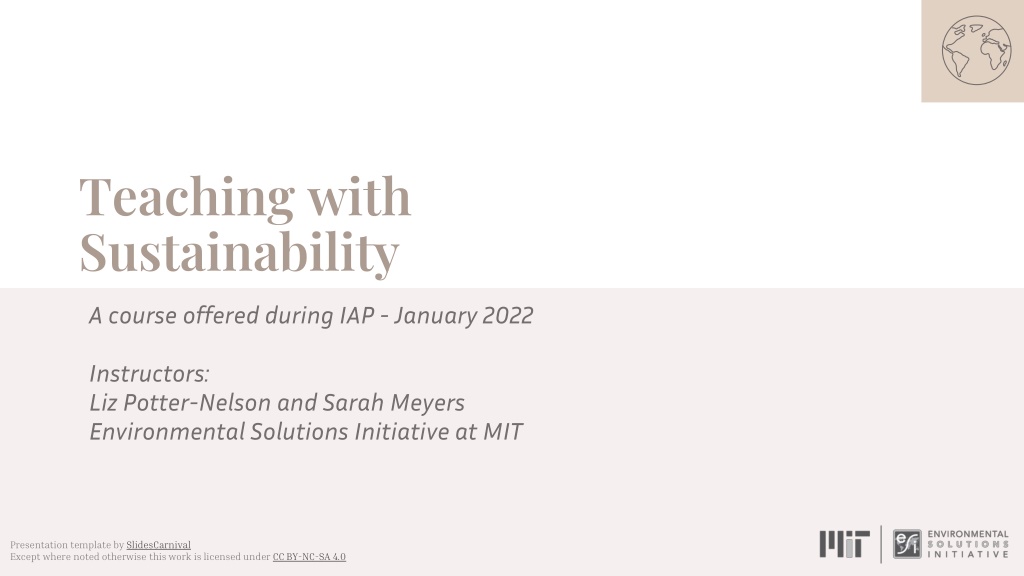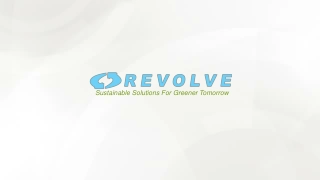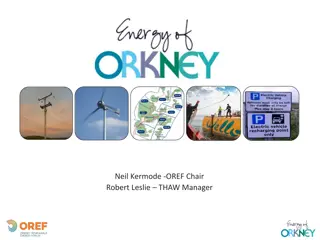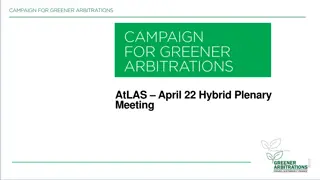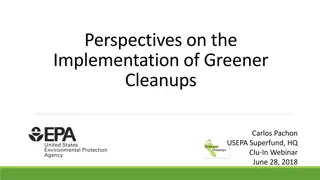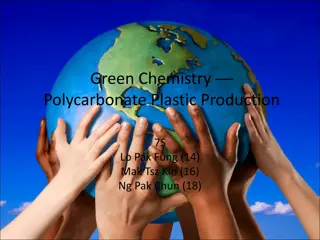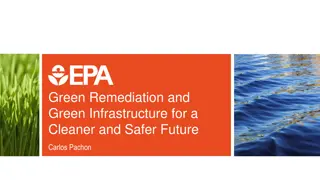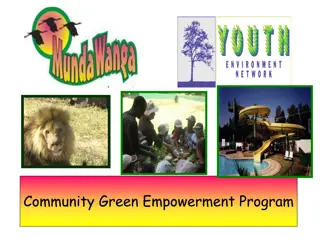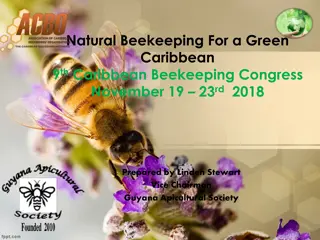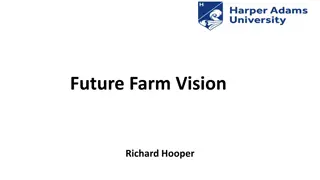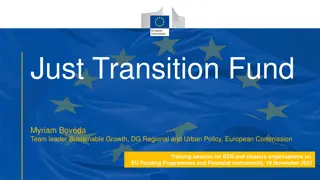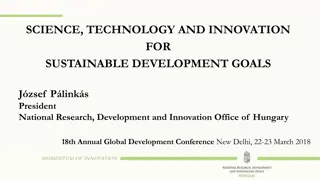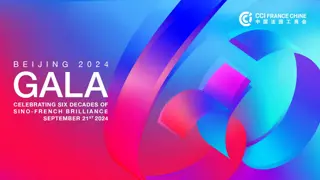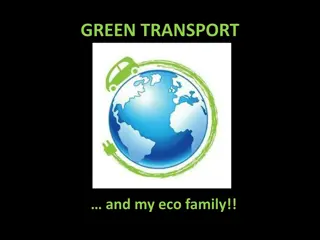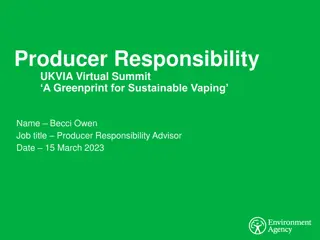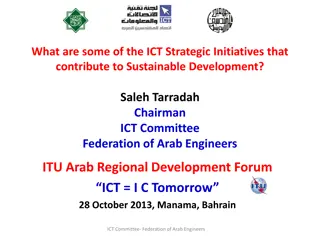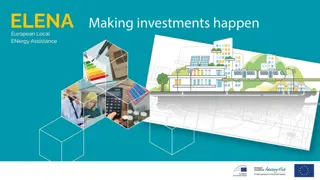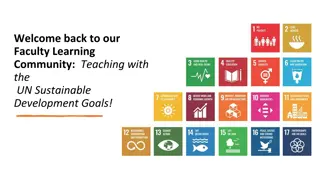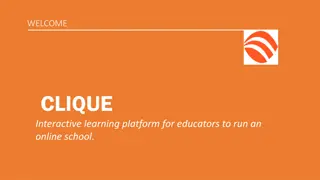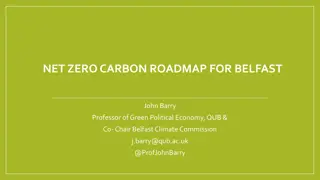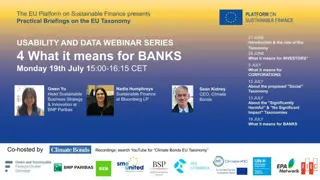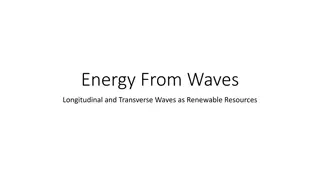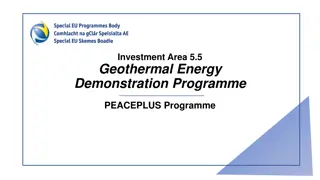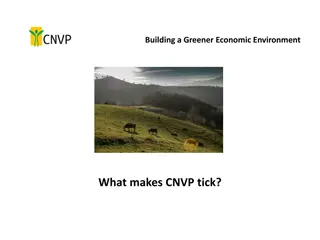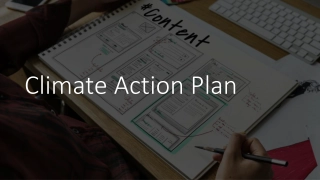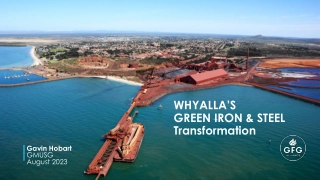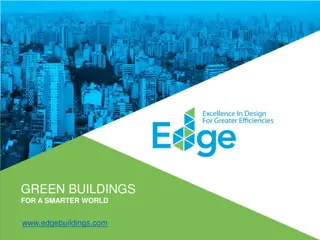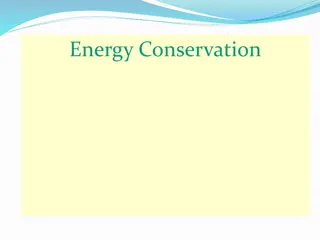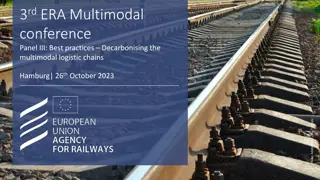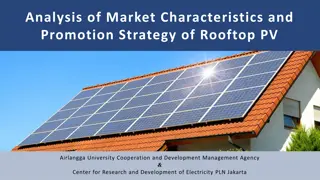Sustainable Education: Empowering Learning for a Greener Future
Dive into the world of sustainability education with instructors Liz Potter-Nelson and Sarah Meyers from MIT's Environmental Solutions Initiative. Explore effective teaching methods, sustainable learning approaches, and paradigms that shape education for a more sustainable world. Gain insights into Bloom's Taxonomy, sustainability literacy competencies, and instructional approaches to enhance your understanding and application of sustainability concepts. Join us on this educational journey towards a more sustainable future.
Download Presentation

Please find below an Image/Link to download the presentation.
The content on the website is provided AS IS for your information and personal use only. It may not be sold, licensed, or shared on other websites without obtaining consent from the author. Download presentation by click this link. If you encounter any issues during the download, it is possible that the publisher has removed the file from their server.
E N D
Presentation Transcript
Teaching with Sustainability A course offered during IAP - January 2022 Instructors: Liz Potter-Nelson and Sarah Meyers Environmental Solutions Initiative at MIT Presentation template by SlidesCarnival CC BY-NC-SA 4.0 SlidesCarnival Presentation template by SlidesCarnival Except where noted otherwise this work is licensed under CC BY-NC-SA 4.0 SlidesCarnival CC BY-NC-SA 4.0
Overview of Topics Week 1 - What is sustainability education? Week 2 - What is effective teaching? Defining sustainability using the Brundtland Report & sustainability education Brief timeline of education to accomplish sustainability initiatives Explanation of a Jigsaw Activity Jigsaw activity of foundational sustainability documents Effective teaching is complex Learning theories provide a framework for how people learn Theoretical perspectives used in sustainability education Sustainability Learning Approaches Positivism vs Postpositivism Positivism and Postpositivism Activity Practicality of Sustainability Education Week 3 Week 3 - - How do we teach sustainably? How do we teach sustainably? Week 4 - What does this look like for me? Asset vs Deficit Asset vs Deficit Approaches Criticism of US Criticism of US Education Bloom s Bloom s Taxonomy Taxonomy Sustainability education looks to paradigm Sustainability education looks to paradigm shifts Levels of implementing Levels of implementing sustainability sustainability Level 1, Level 2, Level Level 1, Level 2, Level 3 3 Transitioning through Sustainability Transitioning through Sustainability Levels Approaches Education Explanation of Categories of Sustainability Literacy Competencies Explanation of Sustainable Instructional Approaches Overview of Understand by Design (UbD) Modified UbD template Sticking Points shifts Presentation template by SlidesCarnival CC BY-NC-SA 4.0 SlidesCarnival Levels 2
How do we teach sustainably? Week 3 Presentation template by SlidesCarnival CC BY-NC-SA 4.0 SlidesCarnival
Learning Objectives for Today Participants will be exposed to Bloom s Taxonomy Participants will explore education about sustainability, education for sustainability, and education as sustainability Participants will consider how this applies to their area of interest. Presentation template by SlidesCarnival CC BY-NC-SA 4.0 SlidesCarnival 4
Opening Activity Linking back to last week and thinking forward to this week, let s take a moment put these different activities on a continuum from least cognitively demanding to most cognitively demanding Investigation: Proposing and conducting an investigation around a topic from class Quiz: Completing a multiple choice quiz Presentation: Giving a presentation about a specific topic Concept Map: Creating a concept map of topics learned in class Compare & Contrast: Comparing & contrasting different viewpoints Interview: Interviewing someone about a class topic Presentation template by SlidesCarnival CC BY-NC-SA 4.0 SlidesCarnival 5
A quick word on Deficit Approach Focuses on what students can t do. If a student is struggling it is because the student is not trying hard enough Can lead to low expectations of students Asset vs. Deficit Approaches in Education Asset Approach Focuses on what students can do, including strengths, skills, talents, and interests Challenges assumptions that we may hold about students Students rise to the challenge when they feel supported What are some reasons that a student may be struggling that are not related to the Presentation template by SlidesCarnival CC BY-NC-SA 4.0 amount they are SlidesCarnival trying? 6
Criticism of Education Education in the United States is often criticized for being a mile-wide and an inch deep. This leads students to a surface-level understanding of the content Students learn material for the test Students learn vocabulary and definitions but not applications Students learn a lot of little things but not how they systematically connected Presentation template by SlidesCarnival CC BY-NC-SA 4.0 SlidesCarnival 7
What are our goals? How do we decide what to teach our students? What are our goals for students? How demanding and/or attainable are these goals? How do we support students in achieving these goals? Presentation template by SlidesCarnival CC BY-NC-SA 4.0 SlidesCarnival 8
Blooms Taxonomy 1956 - Benjamin Bloom presented a taxonomy that allowed for the classification of the cognitive demand of learning objectives In theory, students move up each level of the pyramid as they build their understandings and teachers can facilitate this growth Presentation template by SlidesCarnival CC BY-NC-SA 4.0 SlidesCarnival 9
Scaffolding Scaffolding is used to build and provide support to students. Often the building is from concrete ideas to abstract ideas This can be done during on multiple scales when you are an instructor Responding to a student question Building an idea through a class period Building to abstract ideas in a course You can t just jump into the deep end! Presentation template by SlidesCarnival CC BY-NC-SA 4.0 SlidesCarnival 10
Blooms Taxonomy 2001 Bloom s Taxonomy was revised Replaced nouns with verbs were swapped to better identify the actions at each level Top two levels are swapped - leading to the application of knowledge into something new as the most important in learning Presentation template by SlidesCarnival CC BY-NC-SA 4.0 SlidesCarnival 11
Blooms Taxonomy If nothing else, Bloom s Taxonomy gives us a common language to think about how we can increase the rigor or cognitive demand of our lessons with our students. For many teachers this moves the conversation past rote knowledge into how students are engaging with the information they are learning. Presentation template by SlidesCarnival CC BY-NC-SA 4.0 SlidesCarnival 12
Sustainability Education Sustainability education looks at ways to transform systems of thinking and learning. Looking to shift and/or transcend the paradigms of our learners (Meadows, 2008) There is a time and place for knowledge transfer in school settings, however, if the goal is deeper-level thinking, which leads to transformation, then this likely will not occur with surface-level learning Time and place for everything! Teaching is about choices. Presentation template by SlidesCarnival CC BY-NC-SA 4.0 SlidesCarnival 13
Sustainability Education Sustainability Education is no stranger to the conversation about cognitive demand. Research has pointed to much of sustainability being covered at a surface-level, if at all, in many learning environments (Cortese, 2003; Everett, 2008; Sterling, 2011) Presentation template by SlidesCarnival CC BY-NC-SA 4.0 SlidesCarnival Potter-Nelson Studies 14
Sustainability Education Sterling discusses paradigm shifts in the guise of transformative learning experiences using the terms: First-Order: Change in thinking Second-Order: Change in Behavior Third-Order: Epistemological Change Presentation template by SlidesCarnival CC BY-NC-SA 4.0 SlidesCarnival 15
Sustainability Education Presentation template by SlidesCarnival CC BY-NC-SA 4.0 SlidesCarnival Weiss, M., Barth, M., Wiek, A., & von Wehrden, H. (2021). Drivers and barriers of implementing sustainability curricula in higher education: Assumptions and evidence. Higher Education Studies, 22(2), 42-64. 16
Bold Goals Moving from a Level 1 to a Level 2 is BIG Arguably, it is an even bigger shift to move into a Level 3 from an instructional standpoint.. You have to start somewhere! Small changes lead to big impacts. Presentation template by SlidesCarnival CC BY-NC-SA 4.0 SlidesCarnival 17
What does this look like in practice? Providing examples that are linked to sustainability, climate change, and the environment in problem sets and other worksheets (link) Mentions during lectures about sustainability, climate change, and/or the environment (link) A paper or other writing about how a specific sustainability technology works or affects people. (link) Students giving presentations about specific topics, policies, ideas (link) Listening to podcasts on topics about climate change, sustainability and/or the environment Level 1 - Education about Sustainability Not bad! If the goal is increased cognition, then any of these examples, without reflection, means Presentation template by SlidesCarnival CC BY-NC-SA 4.0 that students may not notice the link to sustainability! SlidesCarnival 18
What does this look like in practice? Experiential learning about the content Creating a school garden (link) Interdisciplinary papers, projects and presentations What are the consequences of this? How will this affect other people? Geoengineering Term Project (link) Student reflection and interaction on any of the lessons from Level 1 Problem sets that encourage reflection Presentations/Final Assignments Side conversations with students Level 2 - Education for Sustainability Often takes more instructional time to implement and needs to Presentation template by SlidesCarnival CC BY-NC-SA 4.0 be intentionally scaffolded. Likely will occur later in a course. SlidesCarnival 19
What does this look like in practice? Level 3 changes are hard to measure without conducting interviews of instructors and/or students. Instructors can set the foundation for a transformative change Some argue systemic change is necessary Level 3 - Education as Sustainability Some students may reach transformative changes with Level 2 Projects D:Lab Project (link) Multi-step Teacher Research Project Thermodynamics w/o combustion engines Presentation template by SlidesCarnival CC BY-NC-SA 4.0 SlidesCarnival 20
Transitioning through Sustainability in Classroom Activities Original Activity Level 1 Level 2 Level 3 Students are working to understand reaction rates in chemistry using a generic chemical equation and scenario. Instead of using a generic equation, instructors have re- centered the problem around the chemical equation for smog Faculty add an additional question after student complete their calculations asking them to reflect on or expand on the social impact of their calculation Students engage in hands-on data collection around smog in local communities and analyze in conjunction with calculations Presentation template by SlidesCarnival CC BY-NC-SA 4.0 SlidesCarnival 21
Transitioning through Sustainability in Classroom Activities Original Activity Level 1 Level 2 Level 3 Students are working to understand reaction rates in chemistry using a generic chemical equation and scenario. Instead of using a generic equation, instructors have re- centered the problem around the chemical equation for smog Faculty add an additional question after student complete their calculations asking them to reflect on or expand on the social impact of their calculation Students engage in hands-on data collection around smog in local communities and analyze in conjunction with calculations Students write a one-page reaction piece to a content area reading. Students write a one-page reaction piece to an environmentally focused content area reading. Students are asked to write a one-page reaction/reflection piece on how their behaviors will change, if at all, based on what they read Students are asked to temporarily change their behavior(s) based on what they read and respond to how it affected them Presentation template by SlidesCarnival CC BY-NC-SA 4.0 SlidesCarnival 22
What are our goals? How do we decide what to teach our students? What are our goals for students? How demanding and/or attainable are these goals? How do we support students in achieving these goals? Presentation template by SlidesCarnival CC BY-NC-SA 4.0 SlidesCarnival 23
Sustainability Education - Reminder Sustainability scholars would argue that the goal is transformative learning in all cases Pragmatically there are different ways to approach sustainability, climate change and the environment in how you teach Presentation template by SlidesCarnival CC BY-NC-SA 4.0 SlidesCarnival 24
Great! But I have so much to teach already, how do I add in one more thing? Sustainability should not become an add-on to your already full curriculum. Find places where your instruction already supports sustainability and be intentional about growing your practice from there. Presentation template by SlidesCarnival CC BY-NC-SA 4.0 SlidesCarnival 25
Great! But Is sustainability or climate change in my content standards? You may not find the words climate or sustainability in your content standards. The skills that you wish to build such as critical thinking, creative thinking, clear communication, analyzing information, and using evidence, are all key skills that support building sustainability literacy in students. Sustainability looks to build knowledge, skills and dispositions for students in the areas of sustainability, systems thinking, social justice, futures thinking and active citizenship. Presentation template by SlidesCarnival CC BY-NC-SA 4.0 SlidesCarnival 26
Where does it fit? Categories of Sustainability Competencies Sustainability Instructional Approaches Sustainability Knowledge Systems Thinking Social Justice Futures Thinking Active Citizenship Content Knowledge Collaborative, Small Group Learning Inquiry-based Learning Experiential Learning Service Learning Place-based Learning Culturally Sustained Learning Presentation template by SlidesCarnival CC BY-NC-SA 4.0 SlidesCarnival 27
Pause for Pedagogy A. Padlet B. Zoom Questions What were strengths of these activities? What were barriers in these activities? What are ways that we could have more fully embodied sustainability in this lesson? Presentation template by SlidesCarnival CC BY-NC-SA 4.0 SlidesCarnival 28
Going Further Articles that address topics from class today: Weiss, M., Barth, M., Wiek, A., & von Wehrden, H. (2021). Drivers and barriers of implementing sustainability curricula in higher education: Assumptions and evidence. Higher Education Studies, 22(2), 42-64. https://doi.org/10.5539/hes.v11n2p42 Paris, D. (2012). Culturally sustaining pedagogy: A needed change in stance, terminology, and practice. Educational Researcher, 41(3), 93 97. https://doi.org/10.3102/0013189X12441244 Sterling, S. (2011). Transformative learning and sustainability: Sketching the conceptual ground. Learning and Teaching in Higher Education, 5, 17-33. Presentation template by SlidesCarnival CC BY-NC-SA 4.0 SlidesCarnival 29
Preview of Next Week Next week please have on hand the resources that you need to (re)vision an activity that you teach or hope to teach to be more sustainable We ll go more in detail on the framework You ll have time to work and share ideas with each other You ll be able to share out what your tentative plan to the large group Presentation template by SlidesCarnival CC BY-NC-SA 4.0 SlidesCarnival 30
Review of Learning Objectives Participants will be exposed to Bloom s Taxonomy Participants will explore education about sustainability, education for sustainability, and education as sustainability Participants will consider how this applies to their area of interest. 1. 2. How will people you interact with know and benefit? What did you learn today? Presentation template by SlidesCarnival CC BY-NC-SA 4.0 SlidesCarnival 31
MIT OpenCourseWare https://ocw.mit.edu RES.ENV-006 Teaching with Sustainability IAP 2022 For more information about citing these materials or our Terms of Use, visit https://ocw.mit.edu/terms. Presentation template by SlidesCarnival CC BY-NC-SA 4.0 SlidesCarnival 32
